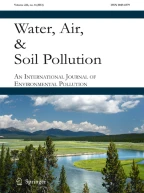Abstract
Istanbul, housing a population over ten million and with population increase rate of approximately twice that of Turkey, is one of the greatest metropolitan cities of the world. As a consequence of rapid population growth and industrial development, Omerli watershed is highly affected by wastewater discharges from the residential areas and industrial plants. The main objective of this study is to investigate the temporal assessment of the land-use/cover of the Omerli Watershed and the water quality changes in the Reservoir. The study is mainly focused on the acquisition and analysis of the Satellite Probatoire de l'Observation de la Terre (SPOT) (1993), Indian Remote Sensing satellite (IRS) (1996 and 2000) and Landsat Thematic Mapper (TM) (2004, 2005, and 2006) satellite images that reflect the drastic land-use/cover changes utilizing the ground truth measurements. The rapid, uncontrolled, and illegal urbanization coupled with insufficient infrastructure has caused the deterioration of the water quality within the past two decades in the Omerli watershed. The water quality analysis of the drinking water Reservoir within the watershed is investigated using 2006 dated Landsat TM satellite digital data. The results are compiled and compared with the water quality measurements of parameters like total nitrogen (TN), the total phosphorus (TP), chlorophyll a (CL) and total dissolved solids (TDS). The observed reflectance shows a strong relationship with the water quality parameters and thus, the satellite data proved to provide a useful index of TN, TP, CL and TDS. Moreover, the linkage between the water quality parameters and the individual band reflectance values are supported by multiple regression analysis.





Similar content being viewed by others
Notes
Chlorophyll a concentrations. (n.d.). Retrieved December 25, 2007, from http://www.ozcoasts.org.au/indicators/chlorophyll_a.jsp.
References
Alexandridis, T. K., Takavakoglou, V., Crisman, T. L., & Zalidis, G. C. (2007). Remote sensing and GIS techniques for selecting a sustainable scenario for Lake Koronia, Greece. Environmental Management, 39(2), 278–290.
Baykal, B. B., Tanik, A., & Gonenc, E. (2000). Water quality in drinking water reservoirs of a Megacity, Istanbul. Environmental Management, 26(6), 607–614.
Baykal, B. B., Tanik, A., & Gonenc, E. (2003). The impact of watershed land-use on maintaining acceptable quality influents for water treatment plants. Journal of Water Supply: Research and Technology-AQUA, 52(8), 587–596.
Brivio, P. A., Giardino, C., & Zilioli, E. (2001). Validation of satellite data for quality assurance in lake monitoring applications. Science of Total Environment, 268, 3–13.
Chen, C., Tang, S., Pan, Z., Zhan, H., Larson, M., & Jönsson, L. (2007). Remotely sensed assessment of water quality levels in the Pearl River Estuary, China. Marine Pollution Bulletin, 54, 1267–1272.
Coskun, H. G., Bayraktar, O., & Yilmaz, L. (2006). Monitoring of protected bands of Terkos drinking water reservoir of metropolitan Istanbul near the Black Sea coast using satellite data. International Journal of Applied Earth Observation and Geoinformation, 8(1), 49–60.
Demography World News (DWN) (2007). Retrieved December 23, 2007, from http://population.wn.com/country/Turkey/Istanbul.
Focardi, S., Corsi, I., Mazzuoli, S., Vignoli, L., Loiselle, S. A., & Focardi, S. (2006). Integrating remote sensing approach with pollution monitoring tools for aquatic ecosystem risk assessment and management: a case study of Lake Victoria (Uganda). Environmental Monitoring and Assessment, 122(1–3), 275–287.
Hellwegera, F. L., Schlossera, P., Lalla, U., & Weissel, J. K. (2004). Use of satellite imagery for water quality studies in New York Harbor. Estuarine, Coastal and Shelf Science, 61, 437–448.
Hua, C., Chena, Z., Claytonb, T. D., Swarzenskib, P., Brockb, J. C., & Muller-Kargera, F. E. (2004). Assessment of estuarine water-quality indicators using MODIS medium-resolution bands: Initial results from Tampa Bay, FL. Remote Sensing of Environment, 93, 423–441.
Istanbul Water and Sewerage Administration (ISKI) (2006), Drinking water watersheds regulation, revised in 25.05.2006
Maktav, D., & Erbek, F. S. (2005). Analysis of urban growth using multi-temporal satellite data in Istanbul, Turkey. International Journal of Remote Sensing, 26(4), 797–810.
Matejicek, L., Engst, P., & Janour, Z. (2006). A GIS-based approach to spatio–temporal analysis of environmental pollution in urban areas: a case study of Prague’s environment extended by LIDAR data. Ecological Modeling, 199(3), 261–277.
Murphy, S. (2007). General information on solids. Retrieved December 25, 2007, from http://bcn.boulder.co.us/basin/data/COBWQ/info/TSS.html.
Omerli–Elmali Joint Venture (OEJV) (1993). Project on Omerli–Elmali protection project, feasibility study, progress report, Istanbul Water and Sewerage Administration, Turkey.
Tanik, A., Baykal, B. B., & Gonenc, I. E. (2000). A long-term management plan for a watershed in a world metropolis-Istanbul. Environmental Management and Health, 11(3), 208–215.
Vignolo, A., Pochettino, A., & Cicerone, D. (2006). Water quality assessment using remote sensing techniques: Medrano Creek, Argentina. Journal of Environmental Management, 81(4), 429–433.
Wang, F., Han, L., & Kung, H. T. (2006). Applications of Landsat-5 TM imagery in assessing and mapping water quality in Reelfoot Lake, Tennessee. International Journal of Remote Sensing, 27(23–24), 5269–5283.
Wang, Y., Xia, H., Fu, J., & Sheng, G. (2004). Water quality change in reservoirs of Shenzhen, China: detection using LANDSAT-TM data. Science of the Total Environment, 328, 195–206.
Wu, C., Wang, Q., Yang, Z., & Wang, W. (2007). Monitoring heated water pollution of the DaYaWan nuclear power plant using TM images. International Journal of Remote Sensing, 28(5), 885–890.
Yuan, D., Lin, B., Falconer, R. A., & Tao, J. (2007). Development of an integrated model for assessing the impact of diffuse and point source pollution on coastal waters. Environmental Modelling & Software, 22(6), 871–879.
Zhao, W., Sasaki, T., & Fujita, S. (2005). Environmental monitoring of industrial waste using remote sensing. Phyton-Annales Rei Botanicae, 45(4), 529–534.
Author information
Authors and Affiliations
Corresponding author
Rights and permissions
About this article
Cite this article
Coskun, H.G., Tanik, A., Alganci, U. et al. Determination of Environmental Quality of a Drinking Water Reservoir by Remote Sensing, GIS and Regression Analysis. Water Air Soil Pollut 194, 275–285 (2008). https://doi.org/10.1007/s11270-008-9716-x
Received:
Accepted:
Published:
Issue Date:
DOI: https://doi.org/10.1007/s11270-008-9716-x

